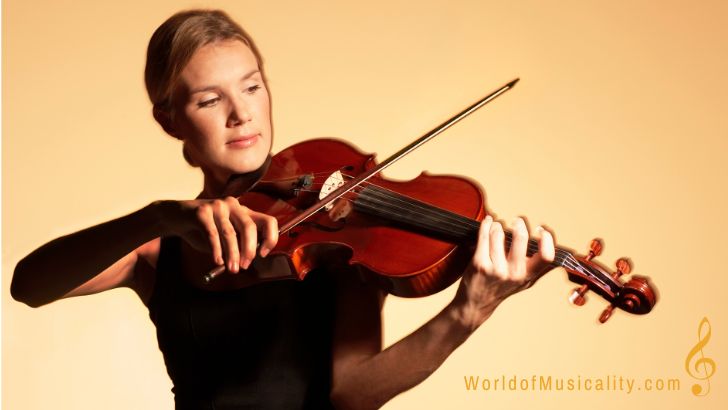
The viola is a string instrument slightly larger than the violin, known for its rich, warm tone. It typically has four strings tuned a fifth below the violin and is a key component of orchestral and chamber music ensembles.
Detailed Instrument Description
| Instrument Name | Viola |
| Instrument Family | String |
| Alternative Names | The viola is known by the same name in many languages, though in some regions, it might be referred to as the “alto” or “altviool” (Dutch). The term “viola” itself originates from an old Italian phrase meaning “of the arm”. |
| Geographical Presence | The viola is played worldwide, being a fundamental part of Western classical music traditions. It is a staple in symphony orchestras, chamber music ensembles, and solo performances across Europe, the Americas, Asia, and beyond. |
| Instrument Classification | The viola falls under the Hornbostel-Sachs classification system as 321.322, identifying it as a bowed string instrument. This system classifies musical instruments based on how they produce sound, with the viola classified as a chordophone where sound is produced by vibrating strings. |
| Unique Features | The viola is known for its deeper, mellower sound compared to the violin. It has a larger body, thicker strings, and a longer neck. The viola’s distinctive timbre adds depth and richness to the string section in an orchestra. |
| Sound Characteristics | The viola produces a rich, warm, and dark sound. Its timbre is often described as more somber and less brilliant than the violin, making it ideal for middle harmonies and supporting roles in orchestral and chamber music. |
| Typical Music Genres | The viola is primarily used in classical music, both orchestral and chamber. It is also found in contemporary classical music, some folk music traditions, and occasionally in jazz and popular music. |
| Components | Body, Neck, Fingerboard, Strings, Pegs, Bridge, Tailpiece, Chin Rest, Sound Post |
| Construction | The viola is traditionally made of wood, such as maple, spruce, and ebony. The body consists of an arched top and back, connected by sides, with a neck extending to the fingerboard. The strings are usually made of gut, synthetic materials, or steel. The instrument is finished with a varnish that affects both its appearance and sound. |
| Size and Weight | The size of the viola can vary, typically ranging from 38 to 43 centimeters (15 to 17 inches) in body length. The weight varies depending on the size and materials used, generally between 500 to 700 grams (1.1 to 1.5 pounds). |
| Variations and Customizations | Variations of the viola include different sizes, shapes, and materials. Customizations might include adjustments to the fingerboard, tailpiece, and chin rest for better ergonomics. Some violas are made with unique varnishes and decorative inlays. |
| Instrument History | The viola’s history dates back to the 16th century, evolving alongside the violin and cello. It played a crucial role in early music ensembles and has grown in prominence in orchestral and solo repertoire. Renowned composers like Mozart, Beethoven, and Brahms have written significant works featuring the viola. |
| Similar Types of Harp | Violin, Cello, Double Bass |
| Playing Technique | The violist uses a bow to produce sound, drawing it across the strings. The left hand presses the strings against the fingerboard to create different pitches. Vibrato, pizzicato, and various bowing techniques are used to add expression and texture to the music. |
| Notable Composers | Paul Hindemith, Béla Bartók, William Walton |
| Famous Works | Hindemith’s “Der Schwanendreher,” Bartók’s “Viola Concerto,” Walton’s “Viola Concerto” |
| Maintenance | Regular maintenance includes tuning the strings, cleaning the body, and occasional string replacement. The bow needs to be re-haired periodically, and the instrument should be stored in a case to protect it from humidity and temperature changes. |
| Learning Difficulty | Moderate to high; requires coordination and dexterity to manage the bow and finger positions. Learning proper hand techniques, bowing styles, and music reading are essential for effective playing. |
| Prominent Players | Lionel Tertis, William Primrose, Yuri Bashmet |
| Notable Performances | Notable performances include concerts by prominent violists at major venues and festivals worldwide, such as the BBC Proms and the International Viola Society Congress. |
| Famous Orchestras/Bands | Prominent ensembles featuring the viola include the Berlin Philharmonic, the Vienna Philharmonic, and the New York Philharmonic. |
| Price Range | Violas range from $1,000 to $10,000 or more, depending on the craftsmanship, age, and materials. Beginner models start around $1,000, while professional models with custom features can exceed $10,000. |
| Interesting Facts | 1. The viola is often considered the “middle voice” of the string family, providing harmony and depth. 2. Lionel Tertis, a pioneering violist, greatly expanded the viola’s solo repertoire. 3. The “Primrose International Viola Archive” is the largest repository of viola music and history. 4. The viola’s size can vary more than any other string instrument, with no standard size. 5. Some of the world’s most famous violists began their careers as violinists before switching to the viola. |
If you would like to learn more facts about the amazing world of musical instruments, visit our homepage at worldofmusiclality.com or click the links below to explore the rest of our site.







